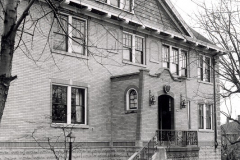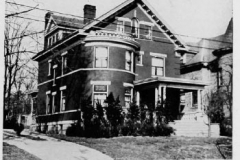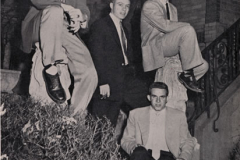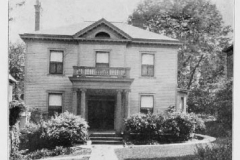Chapter History
The First World War was nearing a climax in the fall of 1918 when four young men entered the University of Cincinnati. Chester Frowe, Charles Hanauer, William Hoeck and Carlton Brown began emergency wartime training at the University as members of the Student Army Corps. On November 11, 1918 the armistice treaty between the Allies and Germany was signed, and these students started their courses again as freshman engineers under the peacetime program.
During this time these four men became acquainted and all were approached by members of the different societies on campus. However, in these organizations, the four found lacking what they most desired… A fraternity that would give in return for the energy that they were willing to contribute.
In December 1920, the four founded a new fraternity at the University of Cincinnati. The name was Iota Chi Epsilon; their motto was Ex Uno Disce Omnes – From One, Judge All; their flower the rose and colors red and gold.
Iota Chi Epsilon (IXE) was chartered on February 11, 1921, by seven members: the four founders plus William Porter, John Porter, and James Clark. On August 5, 1922, it was incorporated under laws of the State of Ohio. Subsequently, the first officers were: Chancellor, Chester Frowe; Vice Chancellor, Charles Hanauer; Secretary, William Hoeck; and Treasurer, Carlton Brown.
During the Fraternity’s first year of existance, IXE presented its first petition to the National Society of Delta Upsilon. The Miami Chapter of DU rejected this petition and subsequent petitions during the next ten years, as they felt it very inadvisable to have another chapter located so close to its own. Despite this disappointment, the chapter grew quickly, and by the end of the 1921-22 school year, membership numbered 22.
Their first meetings were held throughout the community in the houses of several brothers. For the out of town brothers, rooms were rented in a boarding house on Ohio Avenue. Several months after IXE was founded, the brothers rented a house at 255 McCormick Place. In 1924, the house on McCormick Place became too small, so a new house was rented on McMillian Street. In 1928, the fraternity had grown out of the house on McMillian Street and the brothers moved to a place on the river and named it Red Man Camp. It was located on the Kentucky side of the Ohio River near Constance, Kentucky.
In 1937, a house was purchased at 204 Calhoun Street, where Calhoun Residence Hall now stands. In 1941, Iota Chi Epsilon and Beta Kappa were preparing to merge and become Beta Omicron Chapter of Theta Chi. At the last moment, however, a conflict over certain policies arose and IXE withdrew. Beta Kappa became the UC chapter of Theta Chi by itself.
In 1943, the second year of World War II, so many actives had been called into the armed services that Iota Chi Epsilon was forced to become inactive for the duration of the war. An alumni committee took over the house and leased it to Sigma Alpha Epsilon, and then to the government until June, 1946.
During the war, the Mother’s Club of Iota Chi Epsilon continued to function and an alumnus printed the fraternity magazine The Chanticleer. By sending The Chanticleer to all of the members in the armed services, constant contact was maintained among the brothers.
The fraternity was reactivated in June of 1946 and meetings were held all summer to prepare the Fraternity for the coming year in hope of bringing it back to full strength. By September, nearly 35 members had returned to active status. In March, 1949, the IXE Mothers Club bought a plague in memory of Harry Keller, who died serving his country in November, 1948. This was the only casualty the fraternity had.
During the following three years, IXE grew in size and status and was contacted by several national fraternities interested in having them affiliated. Finally, after extensive investigation, the chapter voted on May 3, 1949 to petition Sigma Phi Epsilon for membership.
At the time of the affiliation, IXE stood among the top fraternities at U.C. During the 1948-49 school year, IXE ranked fourth among the 18 fraternities in scholastics, and fifth among 37 organizations in intramurals. During the summer of 1949, membership stood at 73 actives and 13 pledges. On July 30, 1949, the members of Iota Chi Epsilon were initiated into Sigma Phi Epsilon. The Ohio Theta Chapter was born!
IXE PETITIONS SIGMA PHI EPSILON:
It has been said that a fraternity is an organization of kindred people, banded together for their own benefit, looking neither to the welfare of the individual, nor to the community. This misdirected assumption has often given the public an unfavorable view of the whole fraternity system. We believe that a fraternity is a group of kindred people, banded together, but not for their selfish interests. A fraternity is a medium through which the individual can gain experience in comradeship, brotherhood, a medium through which the individual can grow from an adolescent being to a well-developed, well-rounded personality. He must be a person who is able to adapt himself to the problems of everyday living, a person that will be able to be an asset to his community, his country and his God.
Throughout its entire existence, it has been the purpose of Iota Chi Epsilon Fraternity to provide that atmosphere in which such character development could be successfully achieved.
It has been our aim to equip a man with those qualities which are essential for social adjustment, and inner tranquility. We, of Iota Chi Epsilon, feel that these purposes and aims of our fraternity can be strengthened so as to reach new and greater horizons through the affiliation with Sigma Phi Epsilon. it is then with great pride in past achievement and with expectation for an even greater development, that we respectfully petition for membership in Sigma Phi Epsilon.
Iota Chi Epsilon – May 1949
SIGMA PHI EPSILON – OHIO THETA
In February of 1950, shortly after the installation as a SigEp chapter, the first Queen of Hearts Dance was held at the Great Hall of the Student Union. The name Iota Chi Epsilon was still well known on campus, but Sigma Phi Epsilon was not. Something was needed to make the presence of SigEp felt. The brothers believed that an open campus affair would do it, and this dance was the answer. It was a big hit, but over the years has moved to a SigEp invitational dance.
Each year, new growths and expansions took place in the Ohio Theta Chapter of Sigma Phi Epsilon. In 1952, negotiations began for the purchase of the house at 321 Joselin Avenue. After long months of discussions and disappointments, the purchase was concluded and on July 15, 1953, Ohio Theta took possession of its new house. The members worked throughout the rest of the summer removing walls, plumbing, etc., to have an apartment building finished before rush began on September 3. The house was opened, but not completely finished for rush. Thanks to the House Holding Corporation formed in 1953, Ohio Theta had a home.
During the Oregon Conclave in 1953, Ohio Theta invited the Conclave to meet in Cincinnati in 1955, and the offer was accepted. The year following the acceptance was one filled with preparation for this event. The Ohio Valley Conclave, held at the Netherlands Plaza Hotel from August 31 to September 2, was one of the finest and most successful Grand Chapter meetings ever held. Mr. C. Maynard Turner (Washington Beta), the first Ohio Theta House Corporation President was elected Grand Chapter President through the lobbying efforts of his brothers, grateful for his devoted service in Cincinnati.
The Cincinnati Conclave, held from August 31 through September 2, 1955, was decribed in the Journal as a “doozie on wheels.” At previous Conclaves, resolutions to change membership qualifications were “heavily defeated.” That did not happen in Cincinnati, where delegates dug in and wrestled with the membership issue. As a result, legislation restricting membership to white males of Christian birth was removed from the bylaws, appeasing many members. However, the restrictions remained in the ritual for another 4 years. As Uncle Billy looked around the convention, amazed at the chapters represented and the hundreds of loyal SigEps in attendance, he said, “Fifty years ago, we just thought we were building an organization to help a few of us.” Now eighty-two years old, Uncle Billy still kept an office in national headquarters. Sigma Phi Epsilon was his life. This would be Uncle Billy’s last Conclave.
The years of 1956 and 1957 saw a tremendous growth of the chapter in campus activities as the years of work in preparing a solid foundation began to show results. The alumni chapter was reorganized and held a complete program of social events for the first season, and had over 50 members by the turn of the new year in 1958. After only five years in the new house, the chapter had again outgrown its quarters with over 100 members.
Another significant moment in Ohio Theta history occurred at Homecoming 1971. During that night of float preparations, the chapter was having a difficult time building the float. That night a caretaker for some local apartments offered his help to the brothers of Ohio Theta, his name was Donald Hoback. That night Mr. Hoback stayed up all night with the brothers to finish the float. The next day the Ohio Theta float won first place in the Homecoming Parade. Mr. Hoback did not attend the parade, and was not aware of the first place finish. Later that night the brothers thanked Mr. Hoback for all of the time and help that he had donated to SigEp. On March 27, 1974, Donald Hoback was initiated into Sigma Phi Epsilon, Ohio Theta. Don Hoback passed away in 1997; the undergraduate chapter holds a memorial Christmas party in his honor every year.
During the 1980’s Ohio Theta proved itself important to the Greek community at UC, SigEp, and other fraternities as well. In 1986 several alumni and undergraduates created the first ever scholarship to be given to an incoming freshman from a fraternity. The Balanced Man Scholarship had been born and was fully accepted within SigEp and other fraternities.
Another important moment came in 1989 at Conclave. This was the year Ohio Theta started their long standing tradition of winning Buchanan Cups. The Buc-Cup is awarded by SigEp Headquarters to the top 10% of chapters for overall excellence. 1989 was the start of one of the longest consecutive winning streaks in the history of the fraternity; we have won a Buchanan Cup in 1961, 1963, 1969, 1989, 1991, 1993, 1995, 1997, 1997, 1999, 2001, 2003, and 2005.
Furthermore, at the 1993 Conclave, Ohio Theta was selected to perform ritual in front of all the chapters. The Headquarters resolution of this event read as follows:
Resolution #37
RITUAL TEAM RECOGNITION
Whereas the cardinal principles of our Fraternity are embodied by our Ritual, and
Whereas the celebration of our Ritual is an expression of the values of Sigma Phi Epsilon, and
Whereas the Grand Chapter had decreed in the Bylaws the necessity of conducting the Ritual at all Grand Chapter Conclaves, and
Whereas the brothers who performed the Ritual at the 43rd Grand Chapter Conclave in Dallas set a high standard that is full of great respect and proper decorum of the Ritual of Sigma Phi Epsilon; therefore be it
Resolution That the delegates of the 43rd Grand Chapter Conclave held in Dallas, Texas, wish to recognize the talents and efforts of the Ohio Theta Chapter at the University of Cincinnati for their demonstration of the Ritual.
1996 marked the last year Ohio Theta would be a pledge model chapter, adopting the Balanced Man Program in the fall of 1997. The BMP started nationally in 1991, and was presented to Ohio Theta by Headquarters at the ’93 Conclave; after many long discussions, the chapter fully accepted this innovative program. This new concept was based on the philosophy of the ancient Greeks, the idea of healthy body, mind, and spirit. This program removed pledging and replaced it with a development program that spans a man’s entire college career.
In 1999, the chapter celebrated its 50th anniversary. Famous graphic designer and Ohio Theta alumnus, Bruce Blackburn ’61 designed the anniversary logo, while a capital campaign was kicked off and alumni events were planned. Bruce Blackburn is known for designing the red heart logo for SigEp, the National 1976 Bicentennial logo, and the NASA logo. Through increased interest and involvement, the chapter was able to raise over $100,000 in support of Ohio Theta.
In 2003 at the 48th Grand Chapter Conclave in San Antonio, TX the chapter won their 8th consecutive Buchanan Cup. The Grand Chapter recognized Ohio Theta and two other chapters in a brand new form of Buchanan Cup, a gold plated cup titled “Decade of Excellence” because the chapters had won for 10 plus years. Another important event happened at this Conclave; Dr. James F. Robeson, Ohio Theta ’59, was elected Grand Chapter President. The committee to elect the new President was spearheaded by Ryan Hayes, Ohio Theta ’03.
The 2004-2005 school year was another benchmark year in Ohio Theta’s history, as it was accredited as a Residential Learning Community by the National Fraternity. The RLC is an innovative program where UC Faculty holds office hours in the chapter house and guides the members with career, academic, and social goals. Ohio Theta became 1 of 35 chapters to be accredited and 1 of 2 chapters to have four faculty fellows. This school year was one of the most successful years in Ohio Theta’s history, achieving the top campus GPA, winning 9 of 11 campus awards, 5 of 5 personal awards, and were intramural champions.
Summer and Fall of 2005 was a time of joy and sorrow; as they had won the 9th Consecutive Buchanan Cup, held a very successful Balanced Man Scholarship in which Nancy Zimpher, President of UC, was the keynote speaker, and Ohio Theta alumnus and former Grand Chapter President, Dr. James F. Robeson ’59 passed away from a long battle with cancer.
2007 – Ohio Theta was again one of only four chapters to receive the Gold Buchanan Cup at the 2007 Conclave in Atlanta, GA. Receiving this award was another Ohio Theta benchmark, as this was the 20th year in a row; now there are only three other chapters to ever won more Buchanan Cups than Ohio Theta.
February 25, 2008 – John Abraham, President of The Ohio Theta Alumni Volunteer Corporation announced the forthcoming acquisition of the apartment complex beside the 321 Joselin Avenue Ohio Theta chapter house. The complex at 2726 Stratford Avenue has four 2- bedroom apartments plus parking. When asked about the reasoning for the acquisition, John answered, “Our chapter has been experiencing record housing census over the past few years, cumulating with this past fall when we had 39 brothers living in a house with a max capacity of 34 and several brothers living in apartments nearby. So we took the next logical step.”
The escrow process is proceeding smoothly, beginning with the completion of a professional survey. The following steps, which include finalizing the financing, site inspection, and appraisals, are schedule to be completed by March 31st, 2008. A limit number of brothers will be able to move in as soon as this fall, pending any existing lease renewals.












